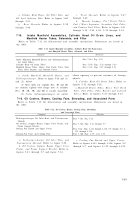TM-9-2815-200-35
ENGINE, WITH CONTAINER:TURBOSUPERCHARGED, DIESEL ,FUEL INJECTION ,90-DEGREE “V” TYPE, AIR - COOLED ,12 - CYLINDER , ASSEMBLY ;MODELS AVDS-1790-2M (2815-856-4996), AVDS-1790-2A AND AVDS-1790-2AM (2815-856-9005)
TECHNICAL MANUAL; DIRECT SUPPORT, GENERAL SUPPORT AND DEPOT MAINTENANCE MANUAL INCLUDING REPAIR PARTS AND SPECIAL TOOLS LISTS
TM-9-2815-200-35 - Page 545 of 779
(para 8-4) and cannot be found through visual
inspection. Perform test as directed in b through
d, below.
b. Remove Cooling Fan Vanes and Cooling
Fans.
Remove cooling fan vanes and cooling
fans (figs. 4-34 and 4-35).
c. Install Sleeve Spacers.
Install two fan rotor
hub sleeve spacers - 4910-795-7952 (fig. 4-87).
d. Test for oil and Fuel Leakage.
(1) Start engine and check for oil and fuel
leaks at hoses, tubes, and all connections inside
engine
“V” and around engine. Tighten hos e
connections or replace leaking hoses, elbows, tee,
and nipples as necessary to correct oil or fuel
leaks.
Note.
Slide fuel injection tube, dust caps (C,
fig. 4-87) away from tube connections at fuel
injection pump to check for fuel leaks.
Note.
DO NOT run engine above idl e
speed, and DO NOT apply load to engine.
(2) Refer to troubleshooting (paras 3-1
through
3-11)
for
probabl e
causes
an d
corrections for other possible leakage points
around engine.
(3) When all points for oil and fuel leaks
have been inspected and / or corrected, remove
fan rotor hub sleeve spacers - 4910-795-7952
(fig. 4-87).
e. Install Cooling Fans.
Install engine cooling
fans (fig. 4-35).
f. Check Coolin g
Fan Blade Clearance .
Check fan blade clearance following instructions
accompanying figure 4-88.
g. Install Cooling Fan Vanes.
Install cooling
fan vanes (fig. 4-34).
8-4.
Engine Run-in
a. General.
This paragraph describes run-in
schedules for overhauled engines prior to being
placed in service. Engine run-in is performed af-
ter overhaul to assist in breaking-in new parts, to
detect faulty assembly. to check for oil leaks, and
to determine whether an engine will operate
satisfactorily when installed in vehicle.
b. Preparation for Run-in.
(1) Couple engine to suitable load. The load
may be a water brake or electric dynamometer.
(2) Remove engine right and left rear upper
covers (figs. 4-127 and 4-141). Remove pip e
plugs from each bank and attach thermocouples
to exhaust manifolds. Reinstall upper covers.
(3) Attach C0
2
fire extinguisher (fig. 8-1).
(4) Remove pipe plug from secondary fuel
filter or pipe plug from fuel/ water separator
(fig. 8-1).
(5) Remove pipe plug (B, fig. 6-6) and
attach piston oil sprayer pressure gage or con-
nection.
(6) Install oil fitting in oil pan.
(7) Remove main oil gallery pipe plug (fig.
8-1) and install main oil gallery thermocouple.
(8) Install main oil gallery pressure con-
nector or attach to oil pressure sending unit (fig.
8-1).
(9) Attach oil inlet and outlet lines to
crankshaft damper housing if external oil cir-
culating system is to be used. If engine is not to
be run on a circulating oil system, lubricate
engine by forcing engine oil under pressure into
the lubrication system to assure adequat e
lubrication of engine parts until the engine oil
pump has time to circulate oil. Fill engine oil pan
with proper grade oil to fill mark on oil level
gage.
(10) Attach fuel inlet line to primary fuel
filter (fig. 8-1).
(11) Attach fuel return line, flywheel end
(fig. 8-2).
(12) Attach turbosupercharger induction air
inlet (fig. 8-1) and exhaust outlet tubes (fig. 8-2).
Connect same type air cleaners that are used
with engine installed in vehicle. (Refer to ap-
plicable Vehicle Technical Manual.) Air intake
should be located so that only cool, fresh air will
be inducated into engine. A means must be
provided for conducting exhaust gases an d
cooling air from engine to avoid recirculation
through engine cooling fans.
(13) Install thermocouple in intake manifold
elbow, both banks (fig. 8-1).
(14) Install manifold pressure gages o r
connections in intake manifold elbows (fig. 8-1),
both banks, set manometers to current we t
barometer reading.
(15) Attach fuel shutoff connection, damper
end, and ascertain to be operative (fig. 8-1).
(16) Turn on oil circulating pump and fuel
supply purge pump .
(a) When fuel flows from secondary fuel
filter or fuel / water separator pipe plug hole, air
has been removed from fuel system. Attach fuel
pressure gage or connection at pipe plug hole.
(b) Oil circulation is checked by loosening
the externally-relieved body bolt (fig. 8-1) on No.
8-3
Back to Top




















